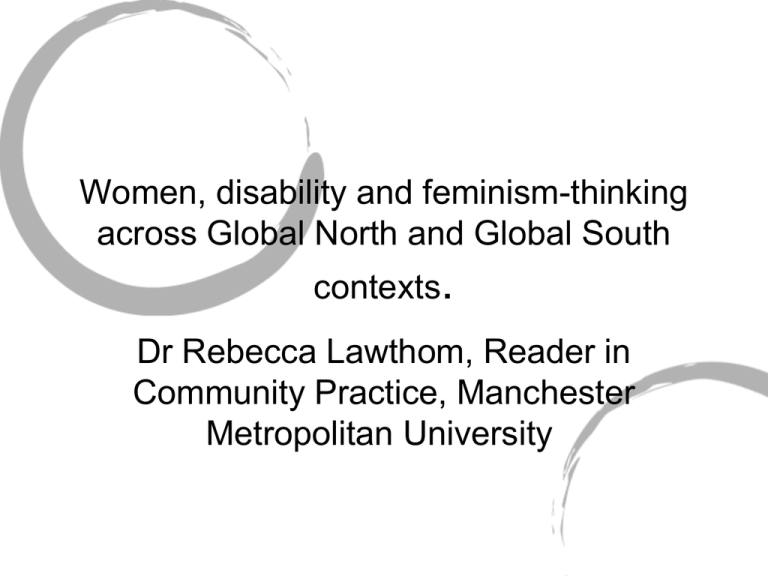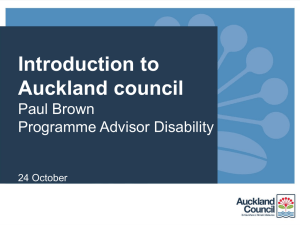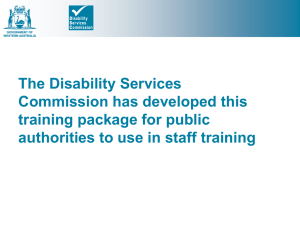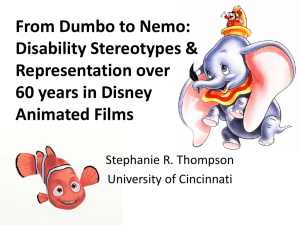
Women, disability and feminism-thinking
across Global North and Global South
contexts.
Dr Rebecca Lawthom, Reader in
Community Practice, Manchester
Metropolitan University
Talk pivots around 4 things
• The importance of place to disability
• The importance of place to gender
• The importance of gender and
contribution of feminism to disability
thinking
• The possibility of disability thinking and
feminism converging
Disability and place
• The knowledge and data we have about
disability differs across different countries and
contexts.
• Global North contexts, disability theorists
within the disability movement are often
advocating for rights in places where welfare
and neoliberalism co-exist.
• Global North contexts import knowledge into
South- power of disability language
Disability defined and imposed
• The charity model: disabled people are to be
pitied and helped through handouts
• Who has the power to define?
• Where do these definitions emerge from?
• Global North or ‘developed’ countries active
makers of meaning around definitions and
aid/help
• The social model: disability is a function of a
disabling society- but whose definition?
Disability lingo exported
• Grech (2010) points out construct is Western,
meaning depends upon hybrid socio-cultural,
political, religious/spiritual and historical contexts in
which disability is placed
• “the meaning of impairment must be understood in
terms of cosmology and values and purposes of
social life’ (Whyte and Ingstad, 1995:10)
• ‘we can deal scientifically and practically with
disability only if we are sensitive to the cultural,
social and psychological structures in which it is
embedded. Every culture poses a challenge to
preconceived notions and forces us to ask anew
how disability is understood, conceptualised and
How does Disability and place
relate and matter?
• 10% of global population disabled (c.650 million
people)- expected to rise to 800 million by 2015
(Peters et al, 2008)
• Currently 150 million of these are children (Grech,
2008) and estimated that 365 million of world’s
working age population are disabled (Disabled World,
2009)
• Place matters: 88% live in the world’s poorest
countries and 90% of those in rural areas (Marks
1999a)
• Ghai (2002) points out that India has a 1 billion
population and approximately 70 million are disabled
How and why does gender
matter?
• In most of the OECD countries females have
higher rates of disability than males.
• Whilst there are more disabled people in the
Southern hemisphere (Stone 1999) the
picture lacks a gender focus (c.f. Ghai, 2002)
• Whatever the focus we know that having a
disability places an individual in the world’s
largest minority group - in an already crowded
theatre of multi-culturalism (Davis 1995)
Disability, gender and
geography
• Gazing upon women less than 3% of
impairment is acquired congenitally meaning
that rest is acquired through health and
violence (domestic, war and conflict)
• Position of women in different contexts further
marginalised by development programmes,
health prevention, sexual ignorance, access
to education and representation
What can a profoundly feminist lens offer
to this global issue?
• I propose some problems, resources and
theoretical mappings which allow a rather
different positioning of girls and women
• A need to unpack disability and disablement
(challenging ableism)
• Shift the focus away from purely structural
and minority world understandings of
disability
Gender and feminism added
to disability studies
• If disability studies is a transdisciplinary space
(Goodley, 2010) a need to explore how
disability, race, sexuality and gender
intersect?
• Feminism has engaged with class and race
(why?) but rather less so with disability
(exceptions here are Morris, 1996: Ghai,
2002, 2006)
• Place is also key here and ‘Global North/
Metropole/minority world’ thinking has given
way to other postcolonial voices - ‘Global
South/Majority world’
Positioning disabled women
•
•
•
•
Meekosha (2004) notes that disabled women are:
More likely to be poor than disabled men
Less likely to access rehabilitation and employment
More likely to experience public space as
threatening
• More likely to live in parental home and experience
sexual abuse
• More likely to remain in abusive relationships due
to reliance on partners for support and child
custody (Olkin, 2003)
Problem 1: Gender blind,
asexual assumptions
• Assumed asexuality of disabled people, particularly
women and even more so those with learning
difficulties
• Little provision for sex education and services for
antenatal care (Cheung, 2009)
• Roets et al 2009 write of wo/men with learning
difficulties’ to give readers options to read the terms
inclusively as well as exclusively
Problem 2: ‘care’ and
disabled mothers
• Prilleltensky (2004) disabled mothers face
discrimination and prejudice during their antenatal
care
• Booth and Booth (2002) find parents with learning
difficulties over scrutinised and under-supported
• Theorists voice the real concern that children of
disabled mothers are taken away from them
• Notions of ‘care’ here problematized as
interdependence - this sits uneasily with care and
disabled people. Disabled people’ cannot be
independent)
Problem 3: un/easy set of relationships
between feminist agenda and disability
studies
• Goodley (2010) notes that non-disabled
feminist have called for freedom of
termination rights and been concerned with
subjugation of women into caring role
• Paradoxically disability and feminism have
shared an over reliance on bodies
constructed as mad, bad and ill - where
women’s bodies categorised through PMT,
hysteria, depression and Munchausen's
syndrome by proxy
The possibility of enmeshing feminism
and critical disability studies
• Thompson (2005) notes that disability studies
and feminism merge around 3 key practices:
retrievals, reimaginings and rethinkings
• Retrievals involves finding women’s writings
that have the power for ‘narrative
recuperation’
• Reimaginings strives to rewrite oppressive
social scripts
• Rethinkings opens disabled feminists to other
theories such as phenomenological,
postructuralism etc
Rethinking: raced gendered
bodies
• Disabling and colonising practices have
historically had similar outcomes
• Disability is compounded by nationhood and
colonialism
• Estimates that 113 primary school children
are not attending school. In India 23 million
(Gabel and Chandler), Africa 80 million
(Ngcobo and Mehuskriska, 2008)
• Women and children who are disabled are
denied equal access to education- literacy
rate of under 5% (DPI)
Rethinking requires
• Understanding and seeing liminality (the
failure to fit social categories)
• Queering settings and practices
• Seeing relationality (especially in the
Global South) as very different
• Miles (2006) critiques the transplanting
of ideas from the ‘metropole’ around
‘rights’, ‘independence’ and
individualism
A more urgent set of concerns
• Ghai (2006) notes 35 million women in India who
suffer discrimination and familial rejection
• Property structures are patriarchal in nature and
disability often viewed as a curse (dowry traditions)
• Up to 10 million girls may have been terminated
due to gender selection
• Girls cost more than boys(colonialist agenda brings
consequences)
• Disabled people cost more than non-disabled in
this context
Retrievals- different narratives
• ‘I am not just an ‘impairment’, nor a
label, nor just a woman, nor simply an
activist. I am also all of these but never
for long. I am cyber-babe, theory chick,
unsettled and unsettling’ from Goodley
and Roets, 2008
Titchkosky’s recuperative
narratives
• Disability here presented as implicit interactions which
can challenge and locate disability as a cultural
phenomenon- the experience of between-ness’.
• She reminds us to ‘watch our watchings, read our
readings’
• She also advocates that we listen to stories ‘ as that is
all we are’
• Critical feminist open up possibilities for exploring new
ways of doing theory, ways that use embodiment as a
theoretical resource for a corporeal epistemology
(Roets et al 2008: 102-103)
Towards a culturally sensitive disability
studies: Interconnections of disability
studies in and across Malaysia and UK
• www.rihsc.mmu.ac.uk/malaysiaukdisabil
ity
• A strand exploring indigenous
knowledges and ways in which care
need cultural understanding
• Care and kinship require indigenous
knowledge
Re-imaginings
• Writing back is a key tenet of postcolonial
theory and decolonising methodologies
(Tuhiwai Smith, 1999)
• Goodley (2010) notes that ‘writing back
invites subjugated voices to re-enter cultural
and political critique’ citing the spoof website
of the Institute for the study of the
neurologically typical (http:/isnt.autistics.org)
The 3 Rs in developing a critical
feminist disability studies
• Reimaginings
• Retrievals
• Rethinkings
• In UK 3Rs associated with education but we
need also to change the world
• The philosophers have only interpreted the
world in various ways. The point, however, is
to change it







